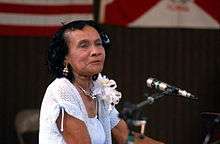Ida Goodson
Ida Goodson (November 23, 1909 – January 5, 2000)[2] was an American classic female blues and jazz singer and pianist.
Ida Goodson | |
|---|---|
 | |
| Background information | |
| Born | November 23, 1909 Pensacola, Florida, United States |
| Died | January 5, 2000 (aged 90) Pensacola, Florida, United States |
| Genres | Classic female blues, jazz[1] |
| Occupation(s) | Singer, pianist |
| Instruments | Vocals, piano |
| Years active | 1920s–2000 |
| Associated acts | Billie Pierce |
Biography
Goodson was born in Pensacola, Florida, the youngest of seven sisters, six of whom survived to adulthood. Her father and mother both played the piano.[2] Her father was a deacon at Mount Olive Baptist Church in Pensacola.[1]
All of the daughters in her family received musical training, with the sole intention that they would perform in church.[1] Goodson noted that the blues were banned in her house.[3] However, Ida and her sisters Mabel, Della, Sadie, Edna, and Wilhelmina (better known as Billie Pierce) all subsequently had careers in blues or jazz.[4] The Preservation Hall Jazz Band often had one of the Goodson sisters playing keyboards. Ida played the piano accompanying silent films and at dances.[1]
The Florida Folk Archive released a recording made at the Florida Folk Festival in 1980, containing a duet between Ida and Sadie. Ida received a Florida Folk Heritage Award in 1987.[2][4]
A 2002 stage show, The Goodson Sisters: Pensacola's Greatest Gift to Jazz, focused on Ida, Wilhelmina, and Sadie. The PBS video Wild Women Don't Have the Blues includes rare footage of Bessie Smith and Ida, her one-time accompanist. The music journalist Chris Heim wrote in the Chicago Tribune that "sprightly blues and gospel performer Ida Goodson—the scene stealer of the film—gives a stunning exhibition of the intimate connection between gospel and blues when she takes the song "Precious Lord" from a rich, slow gospel opening to a rollicking boogie-woogie conclusion."[5]
In her senior years, Goodson played the organ at several churches in Pensacola.[1][4] The album Ida Goodson: Pensacola Piano—Florida Gulf Blues, Jazz, and Gospel was released by the Florida Folklife Program.[4]
See also
References
- Chadbourne, Eugene. "Ida Goodson: Biography". Allmusic.com. Retrieved February 16, 2010.
- "Ida Goodson: Florida Blueswoman". Pineyflatwoodsgirl.blogspot.com. 2007-09-08. Retrieved 2014-01-26.
- Grosz, Elizabeth (1995). Sexy Bodies: The Strange Carnalities of Feminism. London: Routledge. p. 234. ISBN 0-415-09802-5.
- "Folk Heritage Awards Recipient: Ida Goodson". Florida Folklife Program, Preservation, Florida Division of Historical Resources. Dhr.dos.state.fl.us. Retrieved 2014-01-26.
- "The Classic Blues, 1900–1920s". Calliope.org. 2009-01-01. Retrieved 2014-01-26.